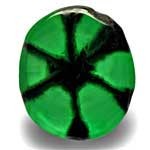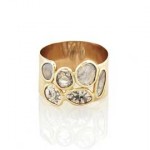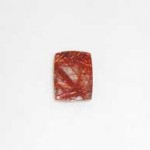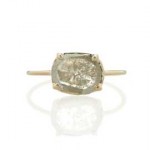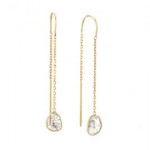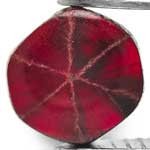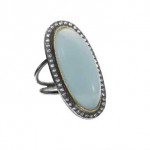
18kt YG and sterling ring, set with oval aquamarine (20.72ct) and white brilliant cut diamonds (0.705ct TW). Photo courtesy Todd Reed, Inc.
It’s been a truism that, for gemstones to sell, they had to be highly transparent, free from inclusions, and of good to excellent color, not to mention of the best modern cuts.
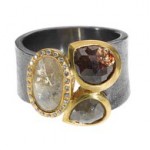
18kt YG and sterling ring set with three fancy cut diamonds, and round white brilliant diamonds. hoto courtesy Todd Reed, Inc.
That is changing, however. Imaginative jewelry designers now showcase the individuality and beauty of pale pastel and translucent varieties of gems such as aquamarine. Old-fashioned rose cuts
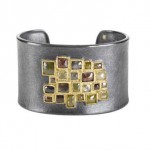
Sterling silver cuff bracelet, set with fancy cut diamonds (14ct TW) and one raw diamond cube (0.01ct). Photo courtesy Todd Reed, Inc.
are making a strong comeback. Designer Todd Reed has made a virtue of rough or “raw” diamonds, stones whose rugged beauty was once crushed for use in industrial
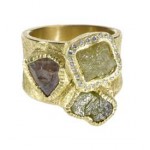
18kt YG ring set with three raw diamonds (11.1ct TW) and round white brilliant diamonds (0.92ct. TW). Photo courtesy Todd Reed, Inc.
diamond tools of all kinds.
Even inclusions—“flaws”—once the bane of jewelers are finding devotees. Diamond slices and other gems show of large, obvious inclusions, such as crystals
and needles, that captivate designers. Trapiches*, once desired only by collectors, are also finding a home in jewelry.
The first chink in the wall of gemstone perfection was probably made by studio jewelers. Creating edgy pieces for a small, art-savvy audience, they opened the door to carved stones, unusual cuts, drusies and raw diamonds. They introduced their clients, more interested in design than intrinsic value, to the variety of agates and jasper, materials once left to the domain of rockhounds and hobby lapidarists.
Now, the demand for the exotic is spilling over into the work of innovative mainstream designers who see the potential of these materials.
The demand for these unusual stones parallels the growing demand for craft and the handmade, say Ava and Eva Bai, co-owners of Vale Jewelry in New York. Both are driven by clients hungry for something unique. Jewelry designers “want to be able to offer their customers what no one else can, something
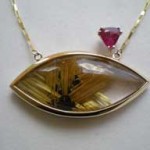
14k YG pendant, set with rutile star in quartz and rubellite. Design: Mark Lasater; fabrication Reese Patton. Photo courtesy Mark Lasater, The Clamshell. 2010.
aesthetic, unique, and rare—all at the same time,” says Mark Lasater, owner of The Clamshell, in Prescott, Arizona, who seeks out included specialties to offer customers. “People understand that these are rarities of nature.” As such, they are even rarer than the sapphires, rubies and emerald found in abundance at any jewelry show.
This search for the unique is especially true of young Millennials, for whom intrinsic value is less important than personal significance, says New York jewelry artist Billie Lim, “They want to have something that has a significant message or meaning,” she says. One of the more unusual stones that fascinates Lim
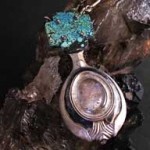
“The Messenger.” Billie Lim. Sterling, chasing/repoussé, set with turquoise, quartz enhydro. Photo courtesy Billie Lim Jewelry.
and her customers are enhydros, gemstones, commonly quartz, that contain fluid inclusions, often with an enclosed gas bubble. “The bubbles have been trapped in this suspended state for no one really knows how long,” says Lim.
Naturally many of these stones are set in fashion jewelry. However, diamond slices even appeal to engagement customers who are “more open to alternatives, something that feels special,” say Ava
and Eva Bai, co-owners of Vale Jewelry in New York, who often use these stones in their work. “It is still a gorgeous stone, but it’s not ‘off-the-shelf’.”
The strongest market for these stones is in the US. “The rest of the world is still taking baby steps when it comes to breaking old traditions in style,” says Tarun Adlakha, owner of Indus Valley Commerce. Buyers
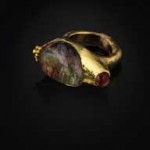
“Mind Field.” Billie Lim. 22kt YG, granulation/repoussé set with quartz lodelite, tourmaline. Photo courtesy Billie Lim Jewelry.
are usually women (from their 20s to mid-40s) with disposable income, a willingness to take risks, and a fashion-forward attitude who are drawn to the untreated natural beauty of the stones. “Men tend to buy more traditionally,” say the Bais. “Women are
more adventurous when treating themselves to a ring they never thought they’d buy.”
These stones will never be available for mass production. They are rare, they may take special skills in setting, and there is a limited number of customers to appreciate them. However, those who do tend to come back for more.
*(Trapiches, Spanish for the mills used to crush sugar cane, olives or ore, occur in gems that crystallize in the hexagonal system–emerald, sapphire, ruby, and tourmaline. Gem material grows from each face of the hexagonal crystal at the heart of the trapiche. Radiating in a six-rayed pattern, from the edges between crystal faces, are lines of–usually black–inclusions.)
A condensed version of this article appeared at JewelleryNetAsia.com on June…

